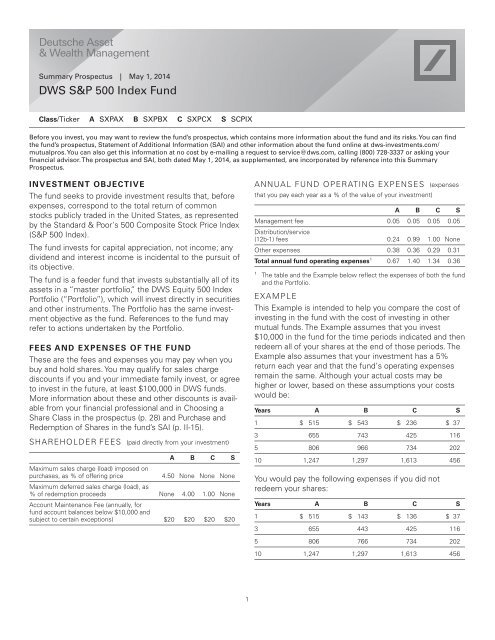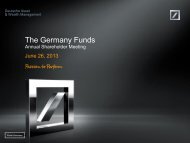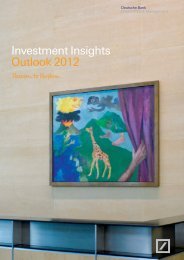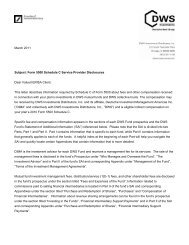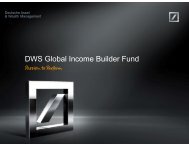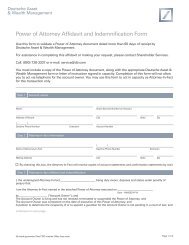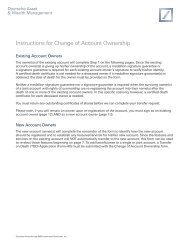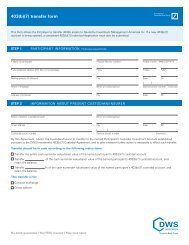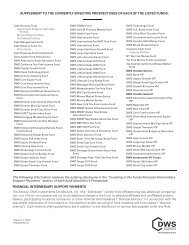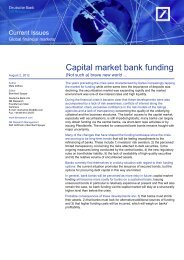Summary Prospectus - DWS S&P 500 Index ... - DWS Investments
Summary Prospectus - DWS S&P 500 Index ... - DWS Investments
Summary Prospectus - DWS S&P 500 Index ... - DWS Investments
You also want an ePaper? Increase the reach of your titles
YUMPU automatically turns print PDFs into web optimized ePapers that Google loves.
<strong>Summary</strong> <strong>Prospectus</strong> | May 1, 2014<br />
<strong>DWS</strong> S&P <strong>500</strong> <strong>Index</strong> Fund<br />
Class/Ticker A SXPAX B SXPBX C SXPCX S SCPIX<br />
Before you invest, you may want to review the fund’s prospectus, which contains more information about the fund and its risks.You can find<br />
the fund’s prospectus, Statement of Additional Information (SAI) and other information about the fund online at dws-investments.com/<br />
mutualpros.You can also get this information at no cost by e-mailing a request to service@dws.com, calling (800) 728-3337 or asking your<br />
financial advisor.The prospectus and SAI, both dated May 1, 2014, as supplemented, are incorporated by reference into this <strong>Summary</strong><br />
<strong>Prospectus</strong>.<br />
INVESTMENT OBJECTIVE<br />
The fund seeks to provide investment results that, before<br />
expenses, correspond to the total return of common<br />
stocks publicly traded in the United States, as represented<br />
by the Standard & Poor’s <strong>500</strong> Composite Stock Price <strong>Index</strong><br />
(S&P <strong>500</strong> <strong>Index</strong>).<br />
The fund invests for capital appreciation, not income; any<br />
dividend and interest income is incidental to the pursuit of<br />
its objective.<br />
The fund is a feeder fund that invests substantially all of its<br />
assets in a “master portfolio,” the <strong>DWS</strong> Equity <strong>500</strong> <strong>Index</strong><br />
Portfolio (“Portfolio”), which will invest directly in securities<br />
and other instruments. The Portfolio has the same investment<br />
objective as the fund. References to the fund may<br />
refer to actions undertaken by the Portfolio.<br />
FEES AND EXPENSES OF THE FUND<br />
These are the fees and expenses you may pay when you<br />
buy and hold shares. You may qualify for sales charge<br />
discounts if you and your immediate family invest, or agree<br />
to invest in the future, at least $100,000 in <strong>DWS</strong> funds.<br />
More information about these and other discounts is available<br />
from your financial professional and in Choosing a<br />
Share Class in the prospectus (p. 28) and Purchase and<br />
Redemption of Shares in the fund’s SAI (p. II-15).<br />
SHAREHOLDER FEES (paid directly from your investment)<br />
A B C S<br />
Maximum sales charge (load) imposed on<br />
purchases, as % of offering price<br />
4.50 None None None<br />
Maximum deferred sales charge (load), as<br />
% of redemption proceeds None 4.00 1.00 None<br />
Account Maintenance Fee (annually, for<br />
fund account balances below $10,000 and<br />
subject to certain exceptions) $20 $20 $20 $20<br />
ANNUAL FUND OPERATING EXPENSES (expenses<br />
thatyoupayeachyearasa%ofthevalueofyourinvestment)<br />
A B C S<br />
Management fee 0.05 0.05 0.05 0.05<br />
Distribution/service<br />
(12b-1) fees 0.24 0.99 1.00 None<br />
Other expenses 0.38 0.36 0.29 0.31<br />
Total annual fund operating expenses 1 0.67 1.40 1.34 0.36<br />
1 The table and the Example below reflect the expenses of both the fund<br />
and the Portfolio.<br />
EXAMPLE<br />
This Example is intended to help you compare the cost of<br />
investing in the fund with the cost of investing in other<br />
mutual funds. The Example assumes that you invest<br />
$10,000 in the fund for the time periods indicated and then<br />
redeem all of your shares at the end of those periods. The<br />
Example also assumes that your investment has a 5%<br />
return each year and that the fund’s operating expenses<br />
remain the same. Although your actual costs may be<br />
higher or lower, based on these assumptions your costs<br />
would be:<br />
Years A B C S<br />
1 $ 515 $ 543 $ 236 $ 37<br />
3 655 743 425 116<br />
5 806 966 734 202<br />
10 1,247 1,297 1,613 456<br />
You would pay the following expenses if you did not<br />
redeem your shares:<br />
Years A B C S<br />
1 $ 515 $ 143 $ 136 $ 37<br />
3 655 443 425 116<br />
5 806 766 734 202<br />
10 1,247 1,297 1,613 456<br />
1
Class B converts to Class A after six years; the Example<br />
for Class B reflects Class A fees after the conversion.<br />
PORTFOLIO TURNOVER<br />
The fund pays transaction costs, such as commissions,<br />
when it buys and sells securities (or “turns over” its portfolio).<br />
A higher portfolio turnover may indicate higher<br />
transaction costs and may mean higher taxes if you are<br />
investing in a taxable account. These costs are not<br />
reflected in annual fund operating expenses or in the<br />
expense example, and can affect the fund’s performance.<br />
Portfolio turnover rate for fiscal year 2013: 3%.<br />
PRINCIPAL INVESTMENT STRATEGY<br />
Main investments. Under normal circumstances, the<br />
Portfolio intends to invest at least 80% of assets, determined<br />
at the time of purchase, in stocks of companies<br />
included in the S&P <strong>500</strong> ® <strong>Index</strong> and in derivative instruments,<br />
such as futures contracts and options, that provide<br />
exposure to the stocks of companies in the index. The<br />
Portfolio’s securities are weighted to attempt to make the<br />
Portfolio’s total investment characteristics similar to those<br />
of the index as a whole. The Portfolio may also hold shortterm<br />
debt securities and money market instruments.<br />
The S&P <strong>500</strong> ® <strong>Index</strong> is a well-known stock market index<br />
that includes common stocks of <strong>500</strong> companies from<br />
several industrial sectors representing a significant portion<br />
of the market value of all stocks publicly traded in the US.<br />
Stocks in the S&P <strong>500</strong> ® <strong>Index</strong> are weighted according to<br />
their total market value. The fund is not sponsored,<br />
endorsed, sold or promoted by the Standard & Poor’s<br />
(S&P) Division of The McGraw-Hill Companies, Inc. While<br />
the market capitalization range of the S&P <strong>500</strong> ® <strong>Index</strong><br />
changes throughout the year, as of the most recent reconstitution<br />
date of the index (March 20, 2014), companies<br />
in the index had a median market capitalization of approximately<br />
$16.96 billion.<br />
Management process. Portfolio management uses quantitative<br />
analysis techniques to structure the Portfolio to<br />
seek to obtain a high correlation to the index while seeking<br />
to keep the Portfolio as fully invested as possible in all<br />
market environments. Portfolio management seeks a longterm<br />
correlation between Portfolio performance, before<br />
expenses, and the index of 98% or better (perfect correlation<br />
being 100%). The Portfolio uses an optimization<br />
strategy, buying the largest stocks in the index in approximately<br />
the same proportion they represent in the index,<br />
then investing in a statistically selected sample of the<br />
smaller securities found in the index.<br />
Derivatives. Portfolio management generally may use<br />
futures contracts, which are a type of derivative (a contract<br />
whose value is based on, for example, indices, currencies<br />
or securities), as a substitute for direct investment in<br />
a particular asset class or to keep cash on hand to meet<br />
shareholder redemptions or other needs while maintaining<br />
exposure to the stock market.<br />
The fund may also use various types of derivatives (i) for<br />
hedging purposes; (ii) for risk management; (iii) for<br />
non-hedging purposes to seek to enhance potential gains;<br />
or (iv) as a substitute for direct investment in a particular<br />
asset class or to keep cash on hand to meet shareholder<br />
redemptions.<br />
Securities Lending. The fund may lend securities (up to<br />
one-third of total assets) to approved institutions.<br />
MAIN RISKS<br />
There are several risk factors that could hurt the fund’s<br />
performance, cause you to lose money or cause the fund’s<br />
performance to trail that of other investments. The fund<br />
may not achieve its investment objective, and is not<br />
intended to be a complete investment program. An investment<br />
in the fund is not a deposit of a bank and is not<br />
insured or guaranteed by the Federal Deposit Insurance<br />
Corporation or any other governmental agency. The fund is<br />
exposed to the risk factors below even if it does not invest<br />
directly in individual securities.<br />
Stock market risk. The fund is affected by how the stock<br />
market performs. When stock prices fall, you should<br />
expect the value of your investment to fall as well.<br />
<strong>Index</strong>ing risk. An index fund’s performance may not<br />
exactly replicate the performance of its target index, for<br />
several reasons. For example, the fund incurs fees, administrative<br />
expenses and transaction costs that the index<br />
itself does not. The fund may use sampling techniques<br />
(investing in a representative selection of securities<br />
included in the index rather than all securities in the index),<br />
or the composition of its portfolio may diverge from that<br />
of the index. Also, while the exposure of the index to its<br />
component securities is by definition 100%, the fund’s<br />
effective exposure to index securities may be greater or<br />
lesser than 100%, and may vary over time. Because an<br />
index fund is designed to maintain a high level of exposure<br />
to its target index at all times, it will not take any steps to<br />
invest defensively or otherwise reduce the risk of loss<br />
during market downturns.<br />
Derivatives risk. Risks associated with derivatives include<br />
the risk that the derivative is not well correlated with the<br />
security, index or currency to which it relates; the risk that<br />
derivatives may result in losses or missed opportunities;<br />
the risk that the fund will be unable to sell the derivative<br />
because of an illiquid secondary market; the risk that a<br />
counterparty is unwilling or unable to meet its obligation;<br />
and the risk that the derivative transaction could expose<br />
the fund to the effects of leverage, which could increase<br />
the fund’s exposure to the market and magnify potential<br />
losses.<br />
Counterparty risk. A financial institution or other<br />
counterparty with whom the fund does business, or that<br />
underwrites, distributes or guarantees any investments or<br />
contracts that the fund owns or is otherwise exposed to,<br />
may decline in financial health and become unable to<br />
2 <strong>DWS</strong> S&P <strong>500</strong> <strong>Index</strong> Fund<br />
<strong>Summary</strong> <strong>Prospectus</strong> May 1, 2014
honor its commitments. This could cause losses for the<br />
fund or could delay the return or delivery of collateral or<br />
other assets to the fund.<br />
Liquidity risk. In certain situations, it may be difficult or<br />
impossible to sell an investment in an orderly fashion at an<br />
acceptable price.<br />
Pricing risk. If market conditions make it difficult to value<br />
some investments, the fund may value these investments<br />
using more subjective methods, such as fair value pricing.<br />
In such cases, the value determined for an investment<br />
could be different than the value realized upon such investment’s<br />
sale. As a result, you could pay more than the<br />
market value when buying fund shares or receive less than<br />
the market value when selling fund shares.<br />
Securities lending risk. Any decline in the value of a portfolio<br />
security that occurs while the security is out on loan<br />
is borne by the fund and will adversely affect performance.<br />
Also, there may be delays in recovery of securities loaned<br />
or even a loss of rights in the collateral should the<br />
borrower of the securities fail financially while holding the<br />
security.<br />
PAST PERFORMANCE<br />
How a fund’s returns vary from year to year can give an<br />
idea of its risk; so can comparing fund performance to<br />
overall market performance (as measured by an appropriate<br />
market index). Past performance may not indicate<br />
future results. All performance figures below assume that<br />
dividends were reinvested. For more recent performance<br />
figures, go to dws-investments.com (the Web site does<br />
not form a part of this prospectus) or call the phone<br />
number included in this prospectus.<br />
For Class A, B and C shares, performance prior to its inception<br />
date is based on the historical performance of the<br />
fund’s original share class (Class S), each adjusted to<br />
reflect the higher net expenses of the relevant share class.<br />
CALENDAR YEAR TOTAL RETURNS (%) (Class S)<br />
These year-by-year returns do not include sales charges, if<br />
any, and would be lower if they did. Returns for other<br />
classes were different and are not shown here.<br />
40<br />
20<br />
0<br />
-20<br />
-40<br />
10.37<br />
2004<br />
4.47<br />
2005<br />
15.37<br />
2006<br />
5.22<br />
2007<br />
-37.25<br />
2008<br />
26.14<br />
2009<br />
14.81<br />
2010<br />
1.72<br />
2011<br />
15.65<br />
2012<br />
31.89<br />
2013<br />
Best Quarter: 15.83%, Q2 2009 Worst Quarter: -21.95%, Q4 2008<br />
Year-to-Date as of 3/31/2014: 1.73%<br />
AVERAGE ANNUAL TOTAL RETURNS<br />
(For periods ended 12/31/2013 expressed as a %)<br />
After-tax returns (which are shown only for Class S and<br />
would be different for other classes) reflect the highest<br />
historical individual federal income tax rates, but do not<br />
reflect any state or local taxes. Your actual after-tax returns<br />
may be different. After-tax returns are not relevant to<br />
shares held in an IRA, 401(k) or other tax-advantaged<br />
investment plan.<br />
Class<br />
Inception<br />
1<br />
Year<br />
5<br />
Years<br />
10<br />
Years<br />
Class A before tax 2/15/2005 25.53 16.18 6.25<br />
Class B before tax 2/15/2005 27.50 16.27 5.95<br />
Class C before tax 2/15/2005 30.61 16.42 5.97<br />
Class S before tax 8/29/1997 31.89 17.58 7.03<br />
After tax on<br />
distributions 31.56 17.23 6.74<br />
After tax on distributions<br />
and sale of fund<br />
shares 21.08 15.42 6.11<br />
Standard & Poor’s<br />
(S&P) <strong>500</strong> <strong>Index</strong><br />
(reflects no deduction for<br />
fees, expenses or taxes) 32.39 17.94 7.41<br />
MANAGEMENT<br />
Investment Advisor<br />
Deutsche Investment Management Americas Inc.<br />
Subadvisor<br />
Northern Trust <strong>Investments</strong>, Inc.<br />
Portfolio Manager(s)<br />
Brent Reeder. Senior Vice President of Northern Trust<br />
<strong>Investments</strong>, Inc. Portfolio Manager of the fund. Began<br />
managing the fund in 2007.<br />
PURCHASE AND SALE OF FUND SHARES<br />
MINIMUM INITIAL INVESTMENT ($)<br />
Automatic<br />
Non-IRA IRAs<br />
UGMAs/<br />
UTMAs<br />
Investment<br />
Plans<br />
ABC 1,000 <strong>500</strong> 1,000 <strong>500</strong><br />
S 2,<strong>500</strong> 1,000 1,000 1,000<br />
For participants in all group retirement plans, and in certain fee-based and<br />
wrap programs approved by the Advisor, there is no minimum initial investment<br />
and no minimum additional investment for Class A, C and S shares.<br />
For Section 529 college savings plans, there is no minimum initial investment<br />
and no minimum additional investment for Class S shares. Because<br />
Class B shares are closed to new investment, existing Class B shareholders<br />
may purchase Class A and C shares with a minimum initial<br />
investment of $50. The minimum additional investment in all other<br />
instances is $50.<br />
3 <strong>DWS</strong> S&P <strong>500</strong> <strong>Index</strong> Fund<br />
<strong>Summary</strong> <strong>Prospectus</strong> May 1, 2014
TO PLACE ORDERS<br />
Mail New Accounts <strong>DWS</strong> <strong>Investments</strong>, PO Box 219356<br />
Kansas City, MO 64121-9356<br />
Additional <strong>Investments</strong> <strong>DWS</strong> <strong>Investments</strong>, PO Box 219154<br />
Kansas City, MO 64121-9154<br />
Exchanges and<br />
Redemptions<br />
Expedited Mail<br />
<strong>DWS</strong> <strong>Investments</strong>, PO Box 219557<br />
Kansas City, MO 64121-9557<br />
<strong>DWS</strong> <strong>Investments</strong>, 210 West 10th Street<br />
Kansas City, MO 64105-1614<br />
Web Site<br />
dws-investments.com<br />
Telephone (800) 728-3337<br />
M – F 8 a.m. – 8 p.m. ET<br />
TDD Line<br />
(800) 972-3006, M – F 8 a.m. – 8 p.m. ET<br />
Initial investments must be sent by mail. You can make<br />
additional investments or sell shares of the fund on any<br />
business day by visiting our Web site, by mail, or by telephone.<br />
The fund is generally open on days when the New<br />
York Stock Exchange is open for regular trading.<br />
Class B shares are closed to new purchases, except for<br />
exchanges and the reinvestment of dividends or other<br />
distributions. Class S shares are only available to a limited<br />
group of investors.<br />
TAX INFORMATION<br />
The fund’s distributions are generally taxable to you as<br />
ordinary income or capital gains, except when your investment<br />
is in an IRA, 401(k), or other tax-deferred investment<br />
plan. Any withdrawals you make from such tax-deferred<br />
investment plans, however, may be taxable to you.<br />
PAYMENTS TO BROKER-DEALERS AND<br />
OTHER FINANCIAL INTERMEDIARIES<br />
If you purchase the fund through a broker-dealer or other<br />
financial intermediary (such as a bank), the fund and its<br />
related companies may pay the intermediary for the sale<br />
of fund shares and related services. These payments may<br />
create a conflict of interest by influencing the broker-dealer<br />
or other intermediary and your salesperson to recommend<br />
the fund over another investment. Ask your salesperson<br />
or visit your financial intermediary’s Web site for more<br />
information.<br />
4 <strong>DWS</strong> S&P <strong>500</strong> <strong>Index</strong> Fund<br />
<strong>Summary</strong> <strong>Prospectus</strong> May 1, 2014 DSPIF-SUM


